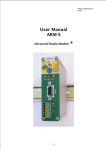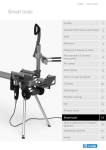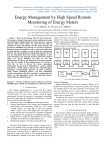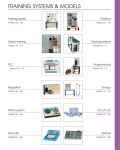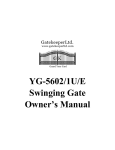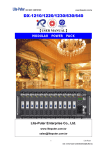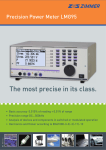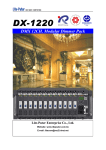Download USER`S MANUAL
Transcript
USER’S MANUAL DC TO AC CONVERTERSINGLE PHASE INVERTER REF. CO-1020 BENCH http: // WWW.LANGLOIS-FRANCE.COM APPLIED PHYSICS PEDAGOGICAL MANUAL DC TO AC CONVERTER SINGLE PHASE INVERTER CO-1020 BENCH Author H. OBEIDI Translation: F. FALCO Lecturers in Applied Physics TABLE OF CONTENT PREAMBLE 3 INTRODUCTION 4 THE CO-120 BENCH 6 PANEL A “Half bridge voltage source inverter” 10 PANEL B “Full bridge voltage source inverter” 11 PANEL A 12 PANEL B 15 WAVEFORM OBSERVATION VOLTAGE AND CURRENT CHARACTERISTICS 18 TECHNICAL SPECIFICATIONS 19 I II III IV Security, environment and EMC Electrical characteristics Safety and directions for use Components replacement VOLTAGE SOURCE INVERTER WAVEFORMS AND SWITCHING COMMAND I II III IV V Switching Square wave command Delayed command Bipolar PWM Unipolar PWM 19 21 24 25 26 26 27 29 31 34 1 LABORATORY WORK HALF BRIDGE VOLTAGE SOURCE INVERTER Resistive load Inductive load Resonant load 39 42 51 56 LABORATORY WORK FULL BRIDGE VOLTAGE SOURCE INVERTER Resistive load Inductive load Resonant load Induction heating Emergency power supply Induction motor drive system 62 63 80 87 93 98 101 2 PREAMBLE The improvement of silicon controlled rectifiers, SCRs, led to the development of a new area of applications called power electronics. Power electronics deals with controlled and conversion of electrical power of semiconductors devices wherein these devices operate as switches. Since the SCRs are available the application area spread to many fields such as motordrives, power supplies, aviation electronics, electronics converters… The main task of power electronics is to control and convert electrical power from one form to another. The CO-120 bench is a pedagogical device which illustrates the concept of AC waveform generation. It is a DC to AC converter and deals with half bridge and full bridge configurations. 3 INTRODUCTION The DC to AC inverter converts DC signal from a DC link (source) to AC waveform to a load. The output frequency can be fixed or modified. The load is fed by a bridge composed of controlled switches. Two configurations are available; half bridge scheme, one leg - two switches and a full bridge scheme, two legs - four switches. Note: The CO-120 bench is an uncontrolled inverter, its output frequency is independent from the mains frequency. General block diagram: DC to AC conversion Inverters can be classified as voltage source inverters, VSIs and current source inverters, CSIs. A voltage source inverter is fed by a DC voltage whereas a current source inverter is fed by a stiff current source. 4 The CO-120 bench feeds resistive load, inductive load, resonant load and AC motors. 5 THE CO-120 BENCH Every single phase inverter configuration can be studied with the CO-120 bench. Fundamentals of power conversion are organized in chosen laboratory works. This pedagogical bench can be used either in secondary degrees, school of engineering or Polytechnic departments. ¾ Half bridge voltage source inverter: Commonly called inverter leg, this configuration needs a central point power supply. This is the basic scheme for the understanding of full bridge, three phase and higher order inverters. 6 ¾ Full bridge voltage source inverter: In this scheme, a single DC power supply is used. If the half bridge presents pedagogical interests, the full bridge introduces industrial and commercial applications. Voltage source inverters are classified according to their output frequency range: • Line (50 Hz in France), emergency power supplies for hospitals, banks computer centre… • Up to 100 Hz, AC variable speeds • From 100 Hz to 40 kHz, induction heating 7 The CO-120 is made of two parts: • Inverter scheme (half or full bridge) • Command board dedicated to switching control (output frequency, command mode, PWM…). Controlled switches are driven by a microcontroller. Practically the bench is very easy to use: two front panels are available, half bridge scheme (Panel A) and full bridge scheme (Panel B). Once the bridge configuration is chosen, user can easily plug DC power supply, loads, meters, scope, current probe… thus the lecturer is able to verify efficiently every benches. Note: Printed circuit and electronics board are protected by resettable switches called “polyswitches”. The Pulse Width Modulation command is very flexible, it can be modified from the command board. This desk monitors pulse width, output frequency and switching angles are displayed (LCD). The output waveform can be improved with the harmonic control using spectrum analyser or a scope including a spectrum analyser. 8 Note: in order to underline the uncontrolled characteristic of the inverter, mains can be replaced by batteries for electronics circuits and the DC link can be replaced by a battery of accumulator instead of a DC power supply. Thus the inverter is line free. 9 PANEL A HALF BRIDGE VOLTAGE SOURCE INVERTER (VSI) HALF BRIDGE VSI scope on / off current probe Square wave Bipolar PWM LOAD PARAMETERS Frequency PWM “a” angle PWM “b” angle PRESENTATION DE LA FACE B 10 ENTER PANEL B FULL BRIDGE VOLTAGE SOURCE INVERTER (VSI) FULL BRIDGE VOLTAGE SOURCE INVERTER on / off scope current probe Square wave Delayed Bipolar PWM Unipolar PWM LOAD PARAMETERS Frequency PWM “a” angle PWM “b“ angle Delay angle “d“ enter 11 PANEL A HALF BRIDGE VOLTAGE SOURCE INVERTER 1 2 4 3 HALF BRIDGE VSI scope on / off current probe 8 12 9 16 5 7 Square wave 14 18 Bipolar PWM 19 LOAD 15 PARAMETERS Frequency PWM “a” angle 6 PWM “b” angle 13 10 11 ENTER 20 12 24 25 26 21 22 23 17 1 Inverter scheme 2 Power 3 Scope output, used to visualized current: 1 V/A 4 Current probe Imax 3A 5 DC link (centre point) +E 6 DC link –E 7 AC load, Imax 3A 8 Current into D1 diode. Current probe for visualization or meter for measuring intensity. 9 Current into T1 transistor. Note: a strap wire must be connected if no current characteristics in the leg is required. 10 Current into D2 diode 11 Current into T2 transistor 12 Unused with Panel A 13 Unused with Panel A 14 T1 command signal 15 T2 command signal 16 Display (LCD). When square wave mode is selected output frequency is displayed. When bipolar PWM mode is selected output frequency and switching angles are displayed. 17 Switching command Note: by default square wave is engaged when power is turned on. Press 17 to modify switching command. 13 18 Red light on when square wave mode is selected 19 Red light on when bipolar PWM is selected 20 Once the switching command is fixed output frequency and switching angles can be modified: a. When square wave mode is able the output frequency can be modified only b. When bipolar PWM mode is able both output frequency and switching angles can be modified Note: by default square wave command and 100 Hz output frequency are set when power is turned on. 21 Green light on when output frequency is being modified 22 Green light on when first switching angle of PWM is being modified 23 Green light on when second switching angle of PWM is being modified 24 Every time 24 is pressed, output frequency is decreased an amount of 1 Hz 25 Every time 24 is pressed, output frequency is increased an amount of 1 Hz Note: press long time 24 or 25 if the required value is high. 26 Enter. Press 26 every time a parameter or a command mode is modified. Note: the 0 V level voltage of the bench power supply, the low voltage of the bridge and 3, 14 and 15 are grounded. 14 PANEL B FULL BRIDGE VOLTAGE SOURCE INVERTER 2 4 3 1 FULL BRIDGE VOLTAGE SOURCE INVERTER scope on / off current probe 18 15 7 8 10 9 19 Square wave Delayed Bipolar PWM 5 Unipolar PWM LOAD 18 PARAMETERS 6 17 Frequency PWM “a” angle PWM “b“ angle Delay angle “d“ 11 12 enter 25 20 15 30 31 32 21 22 23 24 26 27 28 29 1 Inverter scheme 2 Power 3 Scope output, used to visualized current: 1 V/A 4 Current probe Imax 3A 5 DC link 6 AC load 7 Current into transistor T1 Note: a strap wire must be connected if no current characteristics in the leg is required. 8 Current into diode D1 9 Current into diode D2 10 Current into transistor T2 Note: a strap wire must be connected if no current characteristics in the leg is required. 11 Current into diode D3 12 Current into transistor T3 Note: a strap wire must be connected if no current characteristics in the leg is required. 13 Current into transistor T4 Note: a strap wire must be connected if no current characteristics in the leg is required. 14 Current into diode D4 15 T1 command signal 16 T2 command signal 16 17 T3 command signal 18 T4 command signal 19 Display (LCD). When square wave is selected output frequency is displayed. When delayed mode is selected, both output frequency an delay angle are displayed. When bipolar or unipolar mode are selected, both output frequency and PWM angles are displayed. 20 Switching command. Note: by default square wave is engaged when power is turned on. Press 20 to modify switching command. 21 Red light on when square wave mode is selected 22 Red light on when delayed mode is selected 23 Red light on when bipolar PWM mode is selected 24 Red light on when unipolar PWM mode is selected 25 Parameters 26 Green light on when output frequency is being modified 27 Green light on when PWM first angle is being modified 28 Green light on when PWM second angle is being modified 29 Green light on when delay angle is being modified 30 Every time 30 is pressed the output frequency, the first and second PWM angle are decreased respectively an amount of 1 Hz or 1°. 31 Every time 30 is pressed the output frequency, the first and second PWM angle are increased respectively an amount of 1 Hz or 1°. 32 Enter. Press 30 every time a parameter or a command mode is modified. 17 WAVEFORM OBSERVATION / VOLTAGE AND CURRENT CHARACTERISTICS 1 Waveform / voltage measurement Caution: short circuits may occur if user does not remember that many parts of the bench are grounded. Differential probes or differential channels scope must be used when two different waveforms are visualized. Note: Low frequency: use CHOP sweeping mode Trigger (sweeping): use Level button DC mode: full signal, both mean value and wave are displayed 2 Current probe / LEM block The LEM module is a current probe based on Hall effect. AC, DC and AC + DC signals can be measured. Imax : 3A Sensitivity: 1V/A scope scope current probe If no current is measured, a strap wire must be connected as follows: scope Strap wire current probe i T2 Cm2 LOAD 18 TECHNICAL SPECIFICATIONS I SECURITY, ENVIRONMENT AND EMC A SECURITY This product complies with secured voltages: Less than 50 Vrms (AC) Less than 120 V (DC) USER BRIDGE STRUCTURE SWITCHING COMMAND NO PANEL BENCH OFF NONE PANEL A HALF BRIDGE SQUARE WAVE BIPOLAR PWM PANEL B FULL BRIDGE SQUARE WAVE PWM DELAYED a Refer servicing to qualified service personnel only. B ENVIRONMENT Use: + 10 °C to 40 °C Storage: to prevent fire or electrical shock hazard do not expose this product to rain, dust or moisture. 19 C EMC This bench complies with EMC rules II ELECTRICAL CHARACTERISTICS A DC LINK Two kinds of DC power supply can be used: o Desk power supply Ref GPC 3030 90 VA CO-100 bench Note: high capacitors must be added in order to make the power supply reversible. o Battery 12V / 24 V ref CO 106 1 Half bridge – VSI A central point power supply or a couple of batteries must be used. A symmetrical power supply is obtained with two capacitors which have the same value. Then the DC link is equally “split” into two. 2 Full bridge – VSI A desk power supply or a single battery can be used. 12 V or 24 V source voltage 20 B Electronic circuit The electronic board must be supplied by a symmetrical power supply +/- 15 V. Connections are situated at the rear side of the bench. C Power electronic devices 1 Rectifier diode In case of default or damage, diode can be replaced by the following devices: Rectifier PLASTIC PACKAGE TO 194 PLASTIC PACKAGE TO 220 AC IFAV ou Io 5A 8A 100 MR 821 MUR 810 200 MUR 822 MUR 820 400 MR 824 MUR 840 VRRM 21 2 Power transistor PLASTIC PACKAGE TO 220 AB Power transistor ITRMS VDRM 8A [RDS (on)] en Ω 9/13 A [RDS (on)] en Ω MTP 10N10 (0.330) IRF 532 (0.250) BUZ 20 (0.200) BUZ 72 (0.200) 100 IRF 520 (0.300) 150 IRF 633 (0.500) IRF 631 (0.400) 200 IRF 632 (0.500) MTP 12N20 (0.350) BUZ 31 (0.200) BUZ 32 (0.400) VDRM IFAV: maximum average forward current VRRM: repetitive peak inverse voltage ITRMS: RMS on-state current VDRM: repetitive peak off-state voltage D Load Caution: Load must be fed with maximum current of 3A whatever bridge configuration • resistive load : Rheostats Ref. ECO ½ TUBE (320W) (10 Ω ; 5,7 A) ; (15 Ω ; 4,5 A ) ; (22 Ω ; 3,8 A) ; (33 Ω ; 3,1 A), (100 Ω ; 1,8 A), (220 Ω ; 1,2 A), (330 Ω ; 1 A) 22 • inductive load : Ref. PSYJR Iron core coil 0,1 H à 1,4 H/10 Ω/2 A • battery : lead 12 V − 24 V − Ref. CO-106 • single phase transformer : primary : 2 x 12 V secondary : 230 V S : 100 VA • induction motor Ref. MO90/220 230 V / 0,8 A 23 III – Safety and directions for use The following instructions must be respected by the user: 1) Check the laboratory desk; supply, emergency stop switch, warning lights… 2) Lecturer must develop a step-by-step set of instructions on how to follow any experiment. 3) Safety wires must be used only (∅ 4 mm). Coloured wires are recommended. Use strap wires when it is mentioned. 4) Never operate inside the bench while it is powered. 5) Respect maximal values (Imax, Power max…) a Caution: Differential probe should be used in order to avoid any short circuits while waveforms are visualized (the bench is grounded). 6) Use batteries cautiously. Short circuits may occur. 24 IV Power components replacement This bench must stand horizontally and must not be exposed to moisture. a Caution : to prevent electrical shock hazard, the bench must be turned off before any component replacement. a Caution : if one or many components are damaged, it is recommended to check all of them even though they appear undamaged. A component-tester may be useful. All power components are plugged on connectors sold on printed circuit board. 1) Transistor Unscrew the concerned connector, set the transistor and screw all connector terminals. 2) Diode The diode must be correctly fixed. Unscrew the concerned connector. Place the diode (cathode up and anode down) and screw connector terminals. 25 VOLTAGE SOURCE INVERTER WAVEFORMS AND SWITCHING COMMAND I POWER SWITCHES Mosfet and diode work into two states only/ Fully on (conducting) Fully of (blocking) Mosfet transistor is a controllable switch that can be turned on and off by low power control signals. free wheeling diode mosfet bidirectionnal power switch D1 is a free wheeling diode that makes the power switch bidirectionnal whatever the load. When u and I have opposite signs, net power is negative, the load provides energy to DC link. When u and I have same signs, net power is positive, DC link provides energy to load. 26 D is not pictured on the panel however it makes the current into the switch unidirectionnal. Note: switching losses due to rectifier may be considered. II SQUARE WAVE COMMAND It is the easiest configuration. Half bridge inverter (Panel A). The top and the bottom switch has to be complementary, ie if the top switch is closed (on) the bottom one must be off and vice-versa. Full bridge inverter (Panel B). The switching in the second leg is 180° delayed from the first leg. Closed devices PANEL A PANEL B 27 Result: Inductive load R = 10 Ω L = 44 mH (core iron) E = 12 V (battery) Channel A: output voltage Channel B: output current Harmonics analysis Square wave command 28 III. DELAYED COMMAND The switching command of the second leg is delayed from the first leg by an angle called “d”. Closed devices PANEL B d must satisfy d < π when d = 60 °, third harmonic is vanished The pulse width is 120° wide 29 Result: resistive load R = 100 Ω E = 12 V D = 60° Harmonics analysis Delayed command d = 60° third harmonic is vanished 30 IV BIPOLAR PWM PWM is a command technique that improves the quality of the output waveform. In this technique, harmonics are pushed to higher frequencies. Thus the cut-off frequency of the filter is increased. Hence the filter components (ie L and C) size are reduced. Moreover both frequency and amplitude can be independently controlled. A PWM is basically obtained with a triangulation method or natural sampling: Amplitude of the triangular wave (carrier) and sine wave (modulating) are compared to obtain PWM waveform. Simple analog comparator can be used. Bipolar PWM Output voltage changes are from +E or –E Closed devices PANEL A PANEL B Switching angle: a When a = 20°, third harmonic is vanished Total harmonic distorsion, THD is 54.14 % 31 Result: resistive load, full bridge inverter R = 100 Ω E = 12 V a = 20° Bipolar PWM using two switching angles a and b: Closed devices PANEL A PANEL B 32 Third and fifth harmonics are vanished when a = 23.6 ° and b = 33.3 ° (mathematical values) THD is 64.85% Result: resistive load R = 100 Ω E = 12 V a = 24° b = 34° 33 V UNIPOLAR PWM In this technique the output voltage changes are from –E to 0 and 0 to +E: -E; 0; +E Therefore the magnitude of the harmonics are reduced by half. The output waveform presents twice as much notches meaning that the frequency of the harmonics doubled. Switching angle a: Closed devices PANEL B When a = 30° third harmonic is vanished THD is 30.9% 34 Full bridge inverter with resistive load R = 100Ω E = 12 V a = 30° Harmonics analysis Unipolar PWM a = 30° third harmonic is vanished 35 Switching angles a and b: Closed devices PANEL B Third and fifth harmonics are vanished when a = 17.6° and b = 37.8° THD is 60.7% Parameters: By default when 20 is pressed, a = 0° and b= 0°. b angle must be modified before a. a and b must satisfy: 0 d a d b d S/2 36 Result: full bridge inverter, resistive load R = 100 Ω E = 12 V a = 18 ° b = 38° Harmonics analysis Unipolar PWM a = 18°, b = 38° third and fifth harmonics are vanished 37 Note: a and b values can be read directly on the screen of the scope. However cursors can be suitable if the scope is a digital one. 38 LABORATORY WORK HALF BRIDGE VOLTAGE SOURCE INVERTER PANEL A 39 Single phase voltage source inverter can be classified into two types : ¾ Inverter associated with a center-tapped transformer A single DC power supply is required. load DC link ¾ Half bridge inverter (leg inverter) Two different DC links are required. load Note: a DC link can be equally spilt into two if both capacitors have the same value. G becomes the centre point. 40 G load 41 RESISTIVE LOAD The Panel A is set, the bench is supplied (rear side) Scheme : DC link : DC power supply (IMAX = 3 A). Load :rheostat 10 Ω/5,7 A or 33 Ω/3,1 A. Set up every components 42 A – Square wave command I – Power switches When the bench is turned on, square wave mode and 100 Hz output frequency are displayed.. 1) Visualize and plot both T1 and T2 command signals respectively cm1 and cm2. 2) Measure and compare command signals frequency to the displayed frequency. 3) Note that whatever the chosen frequency both signals remain complementary with each other. II – Waveforms Two strap wires are required, CT1 and CT2 respectively associated to T1 and T2. Two strap wires are required, CD1 and CD2 respectively associated to D1 and D2. The load is plugged. CT1 and CT2 are set.. The bench is supplied (+/- 15 V) Symmetric DC link is plugged. Power is turned on, adjust the DC link up to 12 V. ¾ DC link M is grounded E1 and E2 must have the same waveforms (both signals are superposed) 43 Visualize ig1 and ig2 with a current probe. ¾ Inverter S is grounded now. 1) Visualize simultaneously VDS1 and VDS2 (INV) 2) Visualize simultaneously iT1 and iT2, currents into T1 and T2. 3) CD1 is plugged. Visualize ID2 (current probe). 4) CD1 is removed. CD2 is plugged: visualize ID1. ¾ Load M is grounded 1) Visualize the output voltage 2) Visualize the output current III -- Analysis Both transistors are complementary as follows: closed evices Panel A 1) What about voltage losses due to power switches? 2) Deal with the inverter when: 44 E1 = u(t) + VDS1(t) where E1 = E2 = E et VDS2(t) = E2 + u(t) 3) Show that the “the inverter leg “ is a DC to AC waveform converter. 4) Could you expect the output current waveform? IV -- Measurements 1) Fill the following cells: LOAD ÛC scope UC AC + DC UC DC ÎC IC ÎT IT IT VALUES 2) Fill the following cells: MOSFET transistor ÛTinv Values V -- Spectrum analysis E = 12 V; f = 100 Hz The Fourier series of the output voltage is given as: u(t) = 1 4E ⎡ 1 ⎤ sin(ωt ) + sin(3ωt ) + sin(5ωt ) + ...⎥ ⎢ π ⎣ 5 3 ⎦ 45 IC 1) Deal with the fact that only odd harmonics remain. 2) What about the mean value? Verify experimentally. 3) Visualize the output voltage spectrum. - deal with the number of harmonics - compare it with Fourier analysis 4) The fundamental is called u1f - define u1f(t) as a function of E - give RMS expression U1f of u1f as a function of E. Calculate U1f. - what kind of electronic filter can be used in order to select fundamental part of the output signal? - What are the main disadvantages with square wave command? 46 B Bipolar PWM I – Power switches Select bipolar PWM with 17 adjust parameters as follows : f = 200 Hz, a = 35 ° and b = 0 °. "ENTER". 1) Compare cm1 and cm2. 2) Verify f and a with the scope. 3) Visualize and plot both T1 and T2 command signals (cm1 and cm2). Adjust now f = 100 Hz, a = 30° and b = 45° 1) Verify f, a and b with the scope 2) Visualize and plot T1 and T2 command signals 3) What condition a and b must verify to reach bipolar PWM? II -- Waveforms Single angle PWM: E = 12V, f = 200 Hz, a = 35° and b = 0° ¾ DC link Visualize and plot ig1 and ig2 with a current probe ¾ Inverter 1) Visualize and plot simultaneously VDS1 and VDS2 2) Visualize simultaneously iT1 and iT2, currents into T1 and T2. 47 ¾ Load 1) Visualize and plot the output voltage 2) Visualize and plot the output current Repeat previous actions with the following parameters: E = 12V, f = 200 Hz, a = 30° and b = 45 ° III Analysis Both transistors are complementary as follows: Command switching PWM Single angle : closed devices Panel A PWM two angles : closed devices Panel A 48 IV Measurements Fill the following cells : LOAD ÛC Scope UC AC + DC UC DC ÎC IC IC VALUES V – Spectrum analysis : E = 12 V and f = 200 Hz single angle: Fourier series of the output voltage is given as : +∞ u(t) = ∑ b 2k +1 sin( 2k + 1)ωt k =0 where b 2k +1 = 4E [2 cos(2k + 1)a − 1] π(2k + 1) 1) Check the mean value is zero whatever a 2) Compare analysis spectrum when: a = 35 ° b = 0° and and a = 20 b = 0° - what about third harmonic? - Give the first five harmonics of Fourier series of the output voltage for both couple angles and compare with the spectrum analysis. 49 two angles: Fourier series of the output voltage is given as : +∞ u(t) = ∑ b 2k +1 sin( 2k + 1)ωt k =0 where b 2k +1 = 4E [1 − 2 cos(2k + 1)a + 2 cos(2k + 1)b] π(2k + 1) 1) Compare analysis spectrum when: a = 30 ° b = 45° and and a = 24° b = 34° - what about third and fifth harmonics? -Give the first five harmonics of Fourier series of the output voltage for both couple angles and compare with the spectrum analysis. - what kind of electronics filter ca be used in order to select the fundamental of the output signal? 2) Compare square wave and bipolar PWM commands. 50 INDUCTIVE LOAD Panel A is set, the bench is supplied (rear side) Scheme : DC link : DC power supply, current reversible (IMAX = 3 A). Load :rheostat 10 Ω/5,7 A or 33 Ω/3,1 A in series with an iron core coil L (10 Ω/ 0.1 H – 1.4 H) Set up every components 51 R, L Load is connected All strap wires are plugged DC power supplies are connected, E1 = E2 = E = 24 V The bench is turned on A – Square wave command I – Waveforms L = 0,2 H, and f = 50 Hz. ¾ DC link Visualize and plot ig1(t) and ig2(t) ¾ Inverter 1) Visualize simultaneously VDS1 and VDS2 2) Visualize simultaneously VD1 and VD2 3) Visualize and plot simultaneously iT1 and iT2, currents into T1 and T2 4) Visualize and plot iD1 and iD2. ¾ Load 1) Visualize an plot output voltage 2) Visualize and plot output current. 52 II – Analysis Both transistors are complementary as follows : closed devices Panel A 1) Is the output voltage modified by the coil ? 2) What about voltage losses due to power switches? 3) Compare this output voltage with the one obtained with the square wave command. 4) Explain the behaviour of the circuit; - give closed devices for each switching step - give net power sign for each switching step III – Measurements Fill the following cells : LOAD ÛC scope UC AC + DC VALUE 53 UC DC ÎC IC IC IV – Spectrum analysis Fourier series of output voltage is given as : u(t) = 1 4E ⎡ 1 ⎤ sin(ωt ) + sin(3ωt ) + sin(5ωt ) + ...⎥ ⎢ π ⎣ 5 3 ⎦ 1) Visualize and plot output current (current probe) 2) Give harmonics decomposition of output current (from u(t)). What about harmonics level? 3) What kind of load R, L association can simulate? 4) Give fundamental expression i1f(t) of i(t) as a function of E, L, ω and phaseshift. 5) Then give RMS expression I1f of i1f(t). Compare it with spectrum analysis. 54 B – Bipolar PWM Select bipolar PM mode with 17 Adjust parameters as follows: f = 50 Hz, a = 35° and b = 0° Enter ¾ Single angle E = 12 V, f = 50 Hz, a = 20° and b = 0° 1) Visualize and plot command signals, output signals and realize spectrum analysis. 2) Plot switching command diagrams and explain the behaviour of such configuration. ¾ Two angles Repeat previous actions with following parameters: E = 24 V, f = 50 Hz, a = 24° and b =34 ° Note: give closed devices for each switching step give net power sign for each switching step 55 RESONANT LOAD Scheme DC link : DC power supply, current reversible (IMAX = 3 A). Load :rheostat 10 Ω/5,7 A or 33 Ω/3,1 A in series with an iron core coil L (10 Ω/ 0.1 H – 1.4 H) and a capacitor C (22 µF) 56 A – Square wave command I – Power switches Select square wave command Adjust f = 50 Hz Enter 1) Visualize simultaneously command signals of T1 and T2 2) Plot command signals diagram and give closed devices R, L, C Load is connected All strap wires are plugged DC power supplies are connected, E1 = E2 = E = 12 V The bench is turned on II -- Waveforms ¾ DC link Visualize and plot ig1(t) and ig2(t) ¾ Inverter 1) Visualize simultaneously VDS1 and VDS2 2) Visualize simultaneously VD1 and VD2 3) Visualize and plot simultaneously iT1 and iT2, currents into T1 and T2 57 4) Visualize and plot iD1 and iD2. ¾ Load 1) Visualize an plot output voltage 2) Visualize and plot output current. II – Analysis Both transistors are complementary as follows : closed devices Panel A 1) Deal with R, L,C load about output current and command signals waveforms. 2) Adjust L to obtain no phaseshift between output voltage and output current. Output current should become sine wave or quasi sine wave. What is that phenomenon? 3) Check output frequency fo and compare it with theoretical expression. 4) Deal with f < fo and f > fo Note: give closed devices for each switching step give net power sign for each switching step 58 III – Measurements Fill the following cells : LOAD f = fo ÛC scope UC AC + DC UC ÎC IC IC DC VALUE IV – Spectrum analysis f = 210 Hz C = 2.2 µF, L = 0.25 H (resonance is reached) 1) Give quality factor Q = Lωo / RT , where RT is the total resistance of the circuit. 2) Give value of the load when resonance is reached. What about the load impedance before and after resonance? 3) Fourier series of output voltage is given as: u(t) = 1 4E ⎡ 1 ⎤ sin(ωt ) + sin(3ωt ) + sin(5ωt ) + ...⎥ ⎢ π ⎣ 5 3 ⎦ If output frequency matches resonance frequency of the RLC load, the latter behaves as a selecting filter. Harmonics are thus vanished. Note: when output frequency is such as fo / k, the kth harmonic will be considered as a fundamental. 59 Fill the following cells: k (rank) 1 3 5 f (Hz) k.f (Hz) f0 = 210 Hz I (mA) I theoretical Where I = (4E/RT.k.π) 60 7 B – Bipolar PWM Single angle mode Select bipolar PM mode with 17 Adjust parameters as follows: f = 210 Hz, a = 20° and b = 0° Enter Fill the following cells : k (rank) 1 3 5 7 f (Hz) kf (Hz) f0 = 210 Hz Two angles mode Adjust parameters as follows: f = 210 Hz, a = 24 ° and b = 34 ° Enter Fill the following cells: k (rank) 1 3 5 f (Hz) kf (Hz) f0 = 210 Hz 61 7 LABORATORY WORK FULL BRIDGE VOLTAGE SOURCE INVERTER PANEL B 62 RESISTIVE LOAD The Panel B is set, the bench is supplied (rear side) Scheme DC link: DC power supply, Imax = 3 A Load: rheostat R : 10 Ω/5,7 A or 33 Ω/3,1 A. 63 A – Square wave command I – Power switches When the bench is turned on, square wave mode and 100 Hz output frequency are displayed. 1) Visualize and plot T1 and T4 command signals, respectively cm1 and cm4. 2) Measure and compare the command signal frequency to the displayed value. 3) Note that whatever the chosen frequency both signals remain complementary with each other. 4) Visualize and plot T2 and T3 command signals, respectively cm2 and cm3. Both signals must remain complementary. II – Waveforms Four strap wires are required. CT1, CT2, CT3 and CT4 respectively associated to T1, T2, T3 and T4. The load is plugged, all strap wires are set. The bench is supplied (+ / - 15 V). DC link is plugged. Power is turned on, adjust DC link up to 12 V. ¾ DC link Visualize and plot the source output current, ig(t). Inverter 64 A is grounded 1) Visualize simultaneously VDS1 and VDS4 (INV) B is grounded 2) Visualize simultaneously VDS2 and VDS3 (INV) 3) Visualize iT1, iT2, iT3 and iT4 currents into T1, T2, T3 and T4. ¾ Load B is grounded 1) Visualize the output voltage 2) Visualize the output current. III – Analysis Transistors are complementary as follows: closed devices Panel B 1) From previous waveforms, deal with the inverter’s operations. You may use electrical instantaneous relationships. 2) Could you expect such output waveform? 65 IV – Measurements 1) Fill the following cells: LOAD ÛC Scope UC AC + DC UC DC ÎC IC ÎT IT IT VALUES 2) Fill the following cells: MOSFET ÛTinv VALUES V – Spectrum analysis E = 12 V, f = 100 Hz Fourier series of the output voltage is given as: u(t) = 1 4E ⎡ 1 ⎤ sin(ωt ) + sin(3ωt ) + sin(5ωt ) + ...⎥ ⎢ π ⎣ 5 3 ⎦ 1) What about the mean value? 2) Visualize the output voltage spectrum deal with the number of harmonics compare it with Fourier analysis 66 IC 3) The fundamental is called u1f(t). define u1(t) as a function of E Give RMS expression U1f of u1f as a function of E. Calculate U1f. What kind of electronic filter can be used in order to keep fundamental part of the output signal? What are the main disadvantages with square wave command? 67 B – Delayed command I – Power switches Select delayed PWM with 20. Adjust parameters as follows: f = 250 Hz, d = 40 ° Enter 1) Visualize every command signals, cm1, cm2, cm3 and cm4. Signals belonging to the same leg must be complementary and delayed (angle d). 2) Plot cm1, cm2, cm3 and cm4. 3) Adjust d from 0° to highest value. Which values must be verified by d in order to reach delayed command? II – Waveforms Four strap wires are required. CT1, CT2, CT3 and CT4 respectively associated to T1, T2, T3 and T4. The load is plugged, all strap wires are set. The bench is supplied (+ / - 15 V). DC link is plugged. Power is turned on, adjust DC link up to 12 V. ¾ DC link Visualize and plot the source output current, ig(t). 68 Inverter A is grounded 1) Visualize simultaneously VDS1 and VDS4 (INV) B is grounded 2) Visualize simultaneously VDS2 and VDS3 (INV) 3) Visualize iT1, iT2, iT3 and iT4 currents into T1, T2, T3 and T4. ¾ Load B is grounded. 1) Visualize the output voltage 2) Visualize the output current. III – Analysis Transistors are complementary as follows: closed devices Panel B From previous waveforms, deal with the inverter’s operations. You may use electrical instantaneous relationships. 69 IV – Measurements Fill the following cells: LOAD ÛC Scope UC AC + DC UC DC VALUES V – Spectrum analysis E = 12 V Fourier series of the output voltage is given as: +∞ u(t) = ∑ b 2k +1 sin( 2k + 1)ωt k =0 where b 2k +1 = 2E [1 + cos(2k + 1)d] π(2k + 1) 1) What about the mean value? 2) Output voltage spectrum, E= 12 V and f = 250 Hz Adjust d up to 40° 1) Visualize the output voltage spectrum Adjust d up to 60° 70 ÎC IC IC 2) Visualize the output voltage spectrum. Note that the third harmonic is vanished. 3) - Derive first five harmonics when d is 40° and 60°. derive u1f((t) as a function of E thus derive U1f as a function of E calculate E 4) What kind of electronic filter can be used in order to keep the fundamental part of u(t)? Compare square wave command with delayed command. 71 C – Bipolar PWM I – Power switches Select Bipolar PWM with 20 Adjust parameters as follows: f = 150 Hz, a = 40° and b = 0° Enter 1) Measure the output frequency and visualize cm1, cm2, cm3, cm4, and a. Adjust new parameters as follows: f = 150 Hz, a = 30° and b = 45° 2) Measure the output frequency and visualize cm1, cm2, cm3, a and b. 3) Which values must verify a and b in order to reach bipolar PWM? II – Waveforms 1. Single angle PWM: E = 12V, f = 150 Hz, a = 40° and b = 0° 2. Two angles PWM: E = 12V, f = 150 Hz, a = 30° and b = 45° ¾ DC link Visualize and plot the source output current, ig(t). ¾ Inverter 1) Visualize simultaneously VDS1 and VDS4 (INV) 2) Visualize simultaneously VDS2 and VDS3 (INV) 3) Visualize iT1, iT2, iT3 and iT4 currents into T1, T2, T3 and T4. 72 ¾ Load 1) Visualize the output voltage 2) Visualize the output current. III – Analysis Transistors are complementary as follows: closed devices Panel B closed devices Panel B From previous waveforms, deal with the inverter’s operations. 73 IV – Measurements Fill the following cells: LOAD ÛC Scope UC AC + DC UC DC ÎC IC VALUES V – Spectrum analysis E = 12 V Single angle: E = 12V, f = 150 Hz Fourier series of the output voltage is given as: +∞ u(t) = ∑ b 2k +1 sin( 2k + 1)ωt k =0 where b 2k +1 = 4E [2 cos(2k + 1)a − 1] π(2k + 1) 1) What about the mean value? 2) Output voltage spectrum a) Adjust a up to 35° Visualize the output voltage spectrum b) Adjust a up to 20° Visualize the output voltage spectrum. Verify that the third harmonic is vanished. 74 IC c) Derive the first five harmonics of the output voltage. Two angles: E = 12V and f = 250 Hz Fourier series of the output voltage is given as: +∞ u(t) = ∑ b 2k +1 sin( 2k + 1)ωt k =0 where b 2k +1 = a) 4E [1 − 2 cos(2k + 1)a + 2 cos(2k + 1)b] π(2k + 1) Same questions with the following parameters: a = 30° b = 45° b) a = 24° b = 34° Derive first five harmonics c) What kind of electronic filter can be used in order to keep the fundamental part of u(t)? Compare square wave command with bipolar PWM command. 75 D – Unipolar PWM I – Power switches Select Bipolar PWM with 20 Adjust parameters as follows: f = 150 Hz, a = 40° and b = 0° Enter 1) Measure the output frequency and visualize cm1, cm2, cm3, cm4, and a. Adjust new parameters as follows: f = 200 Hz, a = 30° and b = 50° 2) Measure the output frequency and visualize cm1, cm2, cm3, a and b. 3) Which values must verify a and b in order to reach bipolar PWM? II – Waveforms ⇒Single angle PWM: E = 12V, f = 150 Hz, a = 40° and b = 0° ⇒Two angles PWPM: E = 12V, f = 150 Hz, a = 25° and b = 50° ¾ DC link Visualize and plot the source output current, ig(t). ¾ Inverter 1) Visualize simultaneously VDS1 and VDS4 (INV) 2) Visualize simultaneously VDS2 and VDS3 (INV) 3) Visualize iT1, iT2, iT3 and iT4 currents into T1, T2, T3 and T4. 76 ¾ Load 1) Visualize the output voltage 2) Visualize the output current. III – Analysis Transistors are complementary as follows: closed devices Panel B From previous waveforms, deal with the inverter’s operations. IV – Measurements Fill the following cells: LOAD ÛC Scope UC AC + DC VALUES V – Spectrum analysis E = 12 V Single angle: E = 12V, f = 150 Hz Fourier series of the output voltage is given as: 77 UC DC ÎC IC IC +∞ u(t) = ∑ b 2k +1 sin( 2k + 1)ωt k =0 where b 2k +1 = 4E [cos(2k + 1)a ] π(2k + 1) 1) What about the mean value? 2) Output voltage spectrum a) Adjust a up to 40° Visualize the output voltage spectrum b) Adjust a up to 30° Visualize the output voltage spectrum. Verify that the third harmonic is vanished c) Derive the first five harmonics of the output voltage. Two angles: E = 12V and f = 250 Hz Fourier series of the output voltage is given as: +∞ u(t) = ∑ b 2k +1 sin( 2k + 1)ωt k =0 where b 2k +1 = a) 4E [1 − cos(2k + 1)a + cos(2k + 1)b] π(2k + 1) Same questions with the following parameters: a = 25° b = 50° a = 18° b = 38° 78 b) Derive first five harmonics d) What kind of electronic filter can be used in order to keep the fundamental part of u(t)? Compare square wave command with unipolar PWM command. 79 INDUCTIVE LOAD The Panel B is set, the bench is supplied (rear side) Scheme DC link: DC power supply, Imax = 3 A Load: rheostat R : 10 Ω/5,7 A or 33 Ω/3,1 A in series with an iron core coil (10 Ω / 0.1 H – 1.4 H) The R, L load is plugged and all strap wires are set. The DC link is on The bench is turned on, adjust f up to 50 Hz and E up to 24 V 80 A – Square wave command I – Waveforms ¾ DC link Visualize and plot the source output current, ig(t). ¾ Inverter 1) Visualize and plot VDS1, VDS2, VDS3 and VDS4 2) Visualize and plot VD1, VD2, VD3 and VD4 The following table may be useful: point C point D NOT INV INV NOT INV INV A is grounded VDS1 VD1 VD4 VDS4 B is grounded VDS2 VD2 VD3 VDS3 3) Visualize iT1, iT2, iT3 and iT4 currents into T1, T2, T3 and T4. 4) Visualize iD1, iD2, iD3 and iD4 currents into D1, D2, D3 and D4. ¾ Load 1) Visualize and plot the output voltage 2) Visualize and plot the output current 81 II -- Analysis Both transistors are complementary as follows: closed devices Panel B 1) The output voltage is not altered by the iron core coil. Explain the reason why? What about voltage losses due to rectifiers? 2) Compare currents waveforms between inductive and resistive load. 3) From previous waveforms, deal with the inverter’s behaviour. Picture equivalent circuit for each switching step including current’s path. Note: give closed devices for each switching step give net power sign for each switching step III – Measurements Fill the following cells: LOAD ÛC Scope UC AC + DC VALUES 82 UC DC ÎC IC IC IV – Spectrum analysis " E = 24 V et f = 50 Hz Fourier series of the output voltage is given as : u(t) = 1 4E ⎡ 1 ⎤ ω + ω + sin(5ωt ) + ...⎥ sin( 3 t ) sin( t ) ⎢ π ⎣ 5 3 ⎦ 1) Visualize and plot the spectrum analysis of the output current 2) Note that the harmonics level is reduced. Explain thus the influence of the coil. Which consequences may be induced when the load is an ac motor? 3) The fundamental of i1(t) is called i1f(t). define i1(t) as a function of E, L,ω and phaseshift Give RMS expression I1f of i1f . Calculate I1f. 83 B – Delayed command I – Waveforms ¾ DC link Visualize and plot the source output current, ig(t). ¾ Inverter 1) Visualize VDS1,VDS2, VDS3 and VDS4. 2) Visualize VD1,VD2, VD3 and VD4. ¾ Load 1) Visualize the output voltage 2) Visualize the output current. III – Analysis Transistors are complementary as follows: closed devices Panel B From previous waveforms, deal with the inverter’s operations. 84 C – Bipolar and Unipolar PWM commands I – Bipolar PWM Select bipolar mode with 20 Adjust the following parameters: ⇒Single angle : E = 24 V, f = 50 Hz, a= 20° and b = 0° Two angles : E = 24 V, f = 50 Hz, a = 24° and b = 34° Enter 1) Visualize both command signals and output voltage. Note: give closed devices for each switching step give net power sign for each switching step 2) Visualize the output voltage spectrum analysis. II – Unipolar PWM Select bipolar mode with 20 Adjust the following parameters: ⇒Single angle : E = 24 V, f = 50 Hz, a= 40° and b = 0° Two angles : E = 24 V, f = 50 Hz, a = 18° and b = 38° Enter 1) Visualize both command signals and output voltage. 85 Note: give closed devices for each switching step give net power sign for each switching step 2) Visualize the output voltage spectrum analysis. 86 RESONANT LOAD Scheme The load is composed of an iron core coil L, (10 Ω/ 0,1 H - 1,4 H) in series with a capacitor C, 22 µF. 87 A – Square wave command I – Waveforms ¾ DC link Visualize and plot the source output current, ig(t). ¾ Inverter 1) Visualize and plot VDS1, VDS2, VDS3 and VDS4 2) Visualize and plot VD1, VD2, VD3 and VD4 The following table may be useful: point C point D NON INV INV NON INV INV A is grounded VDS1 VD1 VD4 VDS4 B is grounded VDS2 VD2 VD3 VDs3 3) Visualize iT1, iT2, iT3 and iT4 currents into T1, T2, T3 and T4. 4) Visualize iD1, iD2, iD3 and iD4 currents into D1, D2, D3 and D4. ¾ Load 1) Visualize and plot the output voltage 2) Visualize and plot the output current 88 II -- Analysis Both transistors are complementary as follows: closed devices Panel B 5) Deal with the R, L,C load about the output current and command signals waveforms. 6) Adjust L to obtain no phaseshift between output voltage and output current. Output current should become sine wave or quasi sine wave. What is that phenomenon? 7) Measure output current frequency fo. Derive fo. 8) Deal with f < fo and f > fo Note: give closed devices for each switching step give net power sign for each switching step III – Measurements Fill the following cells: LOAD f = fo ÛC Scope UC AC + DC VALUES 89 UC DC ÎC IC IC IV – Spectrum analysis " E = 24 V et f = 50 Hz f = 210 Hz C = 2.2 µF, L = 0.25 H (resonance is reached) 1) Give the quality factor Q = Lωo / RT , where RT is the total resistance of the circuit. 2) Give the value of the load when resonance is reached. What about the load impedance before and after resonance? 3) The Fourier series of the output voltage is given as: u(t) = 1 4E ⎡ 1 ⎤ sin(ωt ) + sin(3ωt ) + sin(5ωt ) + ...⎥ ⎢ π ⎣ 5 3 ⎦ If the output frequency matches resonance frequency of the RLC load, the latter behaves as a selecting filter. Harmonics are thus vanished. Note: when the output frequency is such as fo / k, the kth harmonic will be considered as a fundamental. Fill the following cells: k (rank) 1 3 5 f (Hz) k.f (Hz) f0 = 210 Hz I (mA) I (theoretical) Where I = (4E/RT.k.π) 90 7 B – PWM command Single angle bipolar PWM Select bipolar mode with 20 Adjust parameters as follows: f = 210 Hz, a = 20° and b = 0° Enter Fill the following cells: k (rank) 1 3 5 7 f (Hz) k.f (Hz) f0 = 210 Hz Two angles bipolar PWM Adjust parameters as follows : f = 210 Hz, a = 24 ° and b = 34 °. Enter Fill the following cell: k (rank) 1 3 5 f (Hz) k.f (Hz) f0 = 210 Hz 91 7 The CO 200 bench is a pedagogical support with which the lecturer is able to introduce practical applications like induction heating, emergency power supply or motor drive. The following applications are dedicated to enhance the general knowledge of students. Induction heating Emergency power supply Induction motor speed control 92 INDUCTION HEATING I – Introduction Induction heating can be used in a kitchen. Nowadays electrical or gas cookers can be replaced by induction cooker: A voltage source inverter supplies the primary windings of a transformer which generates a variable magnetic field. Field lines are caught by metallic receptacle (pan, sauce pan…). An emf appears and, as the receptacle is shorted-circuit, eddy currents circulate into. This makes the metallic receptacle to get warmer because of Joules’ effect. The pan acts as the secondary windings of the transformer. secondary cooker electromagnetic field induction coil primary inverter 93 II – Scheme DC link: DC power supply 30 V / 3A Load: Iron core transformer Primary winding: n1 = 125 turns, 3A max Secondary winding: n2 = single loop turn, metallic receptacle induction cooker 94 B – Panel is placed, the bench is supplied (rear side) Select square wave command pressing 20. Adjust f to 50 Hz Enter Set DC link up to 30 V Put water into metallic loop. Switch the bench on. CAUTION : metallic loop may be very hot 95 III – Experiment 1) Is the transformer free, on load or shorted-ciruit? 2) Evaluate eddy currents with a current crowbar (MS 200 – MS 220) 3) Why does secondary current decrease while loop gets warmer? 4) What kind of energy losses do appear? (Joule, Hysteresis, eddy currents…) a) Fill the following cells: E (V) U1 (V) I1 (A) P1 (W) Cos ϕ1 I2 (A) m U2 (V) P2 (W) η 10 20 30 40 50 Where cosϕ: power factor m : transformation ratio η : efficiency b) plot P1 = f(E) and η = f(E) c) Why do we use a step-up transformer? Show that a 500 winding coil is enough to supply the induction cooker from mains (230 V/ 50 Hz)? 96 d) How does an induction cooker work? e) Deal with the resistance of the secondary 5) Lets see how does the induction cooker work as a function of the output frequency. Fill the following cells: f (Hz) 0 50 100 150 200 250 I2 (A) P (W) η 6) Deal with your results. 7) Use delayed or PWM command. Compare both commands (delay angle, a or b angles…) 8) Give the electrical model for the induction cooker: a) How can we obtain sine wave current? (electronic component). b) What is this physical phenomenon? 97 EMERGENCY POWER SUPPLY I – Introduction Voltage source inverter can be used as emergency power supply in many fields like computer systems. If a default appears on the line, the inverter is designed to supply computers or network systems with 230 V / 50 Hz for example. Then work in progress or data can be saved. II – Scheme Inverter bench: CO-120 used as emergency power supply DC link: batteries 24 V Converter bench: CO-100 used as charger Load: 24 V / 40 W bulb 98 1. Charger Refer to laboratory work n°3, active load, of the CO-100 pedagogical 2. Inverter Refer to full bridge laboratory work 3. Charger / Inverter When a default occurs, inverter can be substituted to line. The battery (DC link) must be entirely loaded. Thus in practical application battery output voltage is always regulated. Block diagram: line battery bulb Notes: Electronics is not pictured on the previous block diagram. If the 24 V bulb is replaced by a 230 V one, a step-up transformer must be used as follows: This application may be used to illustrate a lecture or during a laboratory work. 99 100 INDUCTION MOTOR DRIVE SYSTEM I -- Introduction Induction motors presents several advantages; Robust, no brushes High power/weight ratio compared to DC motor Easy to manufacture However it is essentially a fixed-speed machine. Its speed is determined by the supply frequency. Thus to vary its speed, a variable frequency supply is needed. Induction motor is present in many applications like conveyer line drives, traction, electric vehicles, elevators… any industrial process that requires variable speed operation. For variable speed operation, the supply is an inverter. The frequency of the fundamental AC output voltage will set the speed of induction motor. The inverter output frequency must be kept close to the required motor speed. This is necessary as the induction motor operates under low slip conditions. However in order to maintain constant torque, the slip frequency must be maintained over the range of supply frequencies. When maximal motor flux is reached, maximum torque is obtained and, voltage to frequency ratio is kept constant. Constant Voltz/Herzt operation is used. The motor is operated at rated slip at all supply frequencies. Hence a constant torque area is obtained as a function of speed. II – Scheme Source: reversible DC power supply, 0-30 V / 3 A Load: 230 V singlephase induction motor associated to a speed sensor (ref MO90 / 220) Step-up transformer 12V / 230V (ref CO-107) 101 speed Note: the step-up transformer becomes useless according to the induction motor voltage supply. Set the Panel B and switch the bench on (rear side). Set every components and select square wave command with 20. Adjust the frequency up to 50 Hz Enter Set the DC source up to 12 V. III – Experiment 1) Let’s consider the secondary winding of the transformer 102 a) Visualize the secondary voltage uM, use a step down probe. b) Measure both frequency and RMS value of uM. 2) Speed control: a. Fill the following cells: f (Hz) 0 30 50 80 100 150 n (rpm) speed b. At which frequency does the motor stop? Increase thus the DC source level. c. Deal with your results. Plot P = f(E) and η = f(E). 3) Replace the AC motor by a series one and repeat the previous actions. 103 CO1020-GB-08-2005













































































































